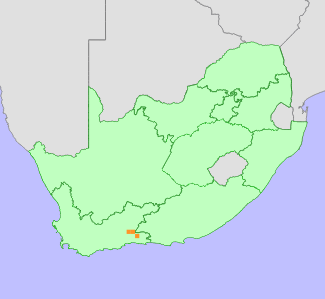|
Scientific Name | Cyclopia alopecuroides A.L.Schutte |
Higher Classification | Dicotyledons |
Family | FABACEAE |
National Status |
Status and Criteria | Endangered B1ab(iii,v)+2ab(iii,v) |
Assessment Date | 2022/10/27 |
Assessor(s) | J.H. Vlok & D. Raimondo |
Justification | This species has a limited distribution range and has an extent of occurrence (EOO) of 490 km ², and an area of occupancy (AOO) of 36 km². It is known from between three locations and the population is declining due to harvesting for the honeybush tea and habitat degradation due to encroachment by invasive alien species and inappropriate fire regimes. It therefore qualifies as Endangered under criterion B. |
Distribution |
Endemism | South African endemic |
Provincial distribution | Western Cape |
Range | This species is endemic to the Western Cape Province, where it is found in the Groot Swartberg and Kammanassie Mountains. |
Habitat and Ecology |
Major system | Terrestrial |
Major habitats | Swartberg Altimontane Sandstone Fynbos, North Swartberg Sandstone Fynbos, Central Inland Shale Band Vegetation |
Description | Plants grow in subalpine montane fynbos occurring on shale bands, 1 500-2 000 m. |
Threats |
| Harvesting for honey bush tea is causing continuing decline to the reseeders (Kammanassie subpopulation), which, unlike the resprouting subpopulations, are unable to cope with harvesting pressure. There has been a long term trade in honeybush but the honeybush tea industry has slowly declined since 2012 and the volumes of exported plants have dropped drastically from 300 tons to only 100 tons being exported in 2021 (Gerrie Ferreira, pers. comm 2022). Subpopulations on the Groot Swartberg are the resprouting form and are not threatened, however this area is infested with invasive alien plants. Too frequent fires in the species' habitat may cause an additional threat to the reseeding subpopulation. |
Population |
The subpopulation on the Kammanassie (the reseeding form of this species) is known from less than 500 plants and is being targeted by the honey bush tea industry, which is suspected to be causing a continuing decline. Further declines may result from competition with invasive alien species and too frequent fires.
|
Population trend | Decreasing |
Assessment History |
Taxon assessed |
Status and Criteria |
Citation/Red List version | | Cyclopia alopecuroides A.L.Schutte | EN B1ab(v) | Raimondo et al. (2009) | |
Bibliography |
Goldblatt, P. and Manning, J.C. 2000. Cape Plants: A conspectus of the Cape Flora of South Africa. Strelitzia 9. National Botanical Institute, Cape Town.
Manning, J.C. and Goldblatt, P. 2012. Plants of the Greater Cape Floristic Region 1: The Core Cape Flora. Strelitzia 29. South African National Biodiversity Institute, Pretoria.
Raimondo, D., von Staden, L., Foden, W., Victor, J.E., Helme, N.A., Turner, R.C., Kamundi, D.A. and Manyama, P.A. 2009. Red List of South African Plants. Strelitzia 25. South African National Biodiversity Institute, Pretoria.
Schutte, A.L. 1997. Systematics of the genus Cyclopia Vent. (Fabaceae, Podalyrieae). Edinburgh Journal of Botany 54(2):125-170.
|
Citation |
| Vlok, J.H. & Raimondo, D. 2022. Cyclopia alopecuroides A.L.Schutte. National Assessment: Red List of South African Plants version . Accessed on 2025/05/31 |
 Comment on this assessment
Comment on this assessment


